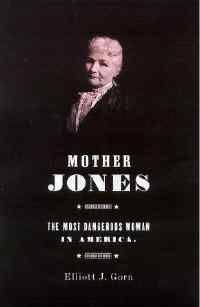Biographies Mary Harris Jones (Mother Jones)

born circa August 1, 1837 in Cork, Ireland
died November 30, 1930 in Silver Spring, Maryland
US-American labor organizer
Biography • Quotes • Weblinks • Literature & Sources
Biography
Labor organizer Mother Jones worked tirelessly for economic justice. While her opponents called her the “most dangerous woman in America,” fellow organizer Elizabeth Gurley Flynn called Jones “the greatest woman agitator of our times.” Jones combined dynamic speaking skills and radical organizing methods to mobilize thousands of laborers and working-class families. She said of herself, “I’m not a humanitarian, I’m a hell-raiser.”
Mary Harris Jones was born approximately August 1, 1837 in Cork, Ireland to Helen Cotter and Richard Harris. She had two brothers and two sisters. Jones later claimed a birthdate of May 1, 1830. Biographers suggest that she chose 1830 to add to the image of white-haired “Mother” Jones, and May first to connect herself to the Haymarket demonstration for the eight-hour day.
Mary’s father moved to the United States in the 1840s, and the rest of the family followed soon thereafter. The Harrises lived in Toronto, Canada where Richard worked in railroad construction. Mary graduated from school and soon became a teacher at a convent in Monroe, Michigan. After briefly trying her hand at dressmaking in Chicago, she resumed teaching, this time in Memphis, Tennessee.
In 1861 Mary married George E. Jones, a member of Iron Molders’ Union in Memphis. Six years later Mary lost her husband and four young children to a yellow fever epidemic, and returned to Chicago to open a seamstress shop. As she sewed clothes for wealthy residents of Chicago, Mary’s resentment of economic inequities grew. After losing all her possessions in the great Chicago fire of 1871, Jones sought community in the Knights of Labor. She committed herself to the labor struggle for humane wages and working conditions.
Having lost her husband and children at the age of 30, Mary began to see the labor movement as her family. She reconstructed herself as “Mother” Jones, radical organizer. Five-feet tall with snow-white hair, all black dress and confrontational style, Jones was indeed a fierce maternal presence. From the late 1870s through the early 1920s, Jones participated in hundreds of strikes across the country. Living by the philosophy, “wherever there is a fight,” she supported workers in the railroad, steel, copper, brewing, textile, and mining industries.
In the 1890s Mother Jones became an organizer for United Mine Workers in West Virginia. She attracted public attention by mobilizing miners’ wives to march with brooms and mops in order to block strikebreakers from entering the mines. Because she disagreed with United Mine Workers’ policy, Jones began working independently of the union. In addition to organizing laborers in the western US, Mother Jones helped found the Social Democratic Party (1898) and the Industrial Workers of the World (1905) and published articles in the International Socialist Review.
Mother Jones opposed female suffrage, fearing that focus on the vote would divert working class women from economic issues. She saw the suffrage movement as an upper class women’s distraction, saying, “the plutocrats have organized their women. They keep them busy with suffrage and prohibition and charity.”
At the same time, Jones often demanded that the government address social injustice. She organized children textile workers to march on President Roosevelt’s home in 1903. Four years later she secured a Congressional inquiry into the fate of Mexican revolutionists imprisoned in America. In 1914, the Colorado militia massacred twenty women and children in a miners’ tent colony in Ludlow, Colorado. Jones persuaded President Wilson to insist that the owners and workers arrive at a truce.
At other times, the authorities were not so tolerant of Mother Jones. When violence broke out during the 1912-13 mine strike in West Virginia, a state military court convicted her of conspiracy to commit murder. Nationwide protest led the governor to commute her twenty-year sentence.
In her eighties Jones supported strikes involving streetcar, garment and steel workers. She also wrote her autobiography and traveled to Mexico for the 1921 Pan American Federation of Labor. Mother Jones lived her last years with her friends Walter and Lillie May Burgess in Silver Spring, MD. On her self-proclaimed 100th birthday, she received many congratulatory messages and gave a speech for a moving picture camera.
Mary Harris Jones died on November 30, 1930. After being celebrated by a mass in Washington, D.C., she was buried at the Union Miners Cemetery in Illinois, next to victims of the Virden, Illinois mine riot of 1898. Her funeral was attended by thousands of mine workers and other mourners.
Author: Sarah K. Horsley
Quotes
Mother Jones was often accused of being an “unladylike.” Her response was “a lady is the last thing on earth I want to be. Capitalists sidetrack the women into clubs and make ladies of them.”
“Pray for the dead and fight like hell for the living.”
“My address is like my shoes. It travels with me. I abide where there is a fight against wrong.”
“No matter what the fight, don't be ladylike! God almighty made women and the Rockefeller gang of thieves made the ladies.”
“I asked a man in prison once how he happened to be there and he said he had stolen a pair of shoes. I told him if he had stolen a railroad he would be a United States Senator.”
“The employment of children is doing more to fill prisons, insane asylums, almshouses, reformatories, slums, and gin shops than all the efforts of reformers are doing to improve society.”
Links
http://www.onlineuniversity.net/history/mother-jones/
Literature & Sources
Dilliard, Irving and Mary Sue Dilliard Schusky, “Mary Harris Jones,” in Notable American Women 1607-1950: A Biographical Dictionary, Volume II, Edward T. Wilson, editor; Janet Wilson James, associate editor; Paul S. Boyer, assistant editor. Cambridge, Mass and London, England: Belknap Press of Harvard University Press, 1971, pages 286-288.
Gorn, Elliot J., “Mother Jones,” in American National Biography, Volume 12. John A. Garraty and Mark C. Carnes, general editors. New York/Oxford: Oxford University Press, 1999, pages 230-231.
 Gorn, Elliot J., Mother Jones: The Most Dangerous Woman in America. New York: Hill and Wang (a division of Farrar, Straus and Giroux), 2001, esp. pages 7-10. [This book has some nice photos of Mother Jones – pages 5 (at a street demonstration), 94, 179 (helping some kids), 236 (speaking with fervor)].
Gorn, Elliot J., Mother Jones: The Most Dangerous Woman in America. New York: Hill and Wang (a division of Farrar, Straus and Giroux), 2001, esp. pages 7-10. [This book has some nice photos of Mother Jones – pages 5 (at a street demonstration), 94, 179 (helping some kids), 236 (speaking with fervor)].
Lewis, Jone Johnson, “Mother Jones Book Review: The Most Dangerous Woman in America,” 2003. (Review of Gorn’s book on the website “What You Need to Know About Women’s History” )
“Mary Harris Jones.” Encyclopedia of World Biography, second edition. 17 Vols. Gale Research, 1998.
“Mother Jones.” Contemporary Heroes and Heroines, Book II. Edited by Deborah Gillan Straub. Gale Research, 1992.
If you hold the rights to one or more of the images on this page and object to its/their appearance here, please contact Fembio.



